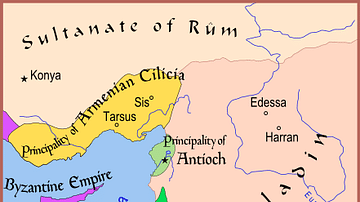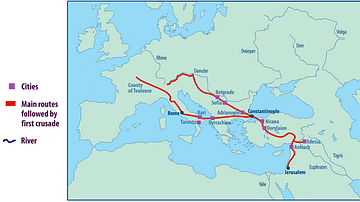Illustration
This map illustrates the shifting frontiers of the Byzantine Empire from the accession of Justinian I (reign circa 527 - 565) to the Fourth Crusade's sack of Constantinople in 1204, showing how the Greek-speaking eastern Roman state acted as both a military bulwark and a cultural bridge between medieval Europe and the Muslim world.
Justinian’s armies briefly restored Roman Mediterranean unity, but later centuries saw losses to Slavs, Bulgars, and successive Muslim caliphates. A revival peaked under Basil II (reign circa 976 - 1025), who crushed Bulgaria and expanded into Armenia, yet civil strife, the Seljuk victory at Manzikert (1071), and Venetian economic leverage eroded Byzantine strength. In 1204 a Venice-backed Fourth Crusade toppled Constantinople, replacing Byzantine rule with the Latin Empire and splintering the remnants into successor states—Nicaea, Epirus, and Trebizond.
About the Author
Cite This Work
APA Style
Netchev, S. (2022, March 09). Map of the Byzantine Empire, c.520 - 1204. World History Encyclopedia. Retrieved from https://www.worldhistory.org/image/15330/map-of-the-byzantine-empire-c520---1204/
Chicago Style
Netchev, Simeon. "Map of the Byzantine Empire, c.520 - 1204." World History Encyclopedia. Last modified March 09, 2022. https://www.worldhistory.org/image/15330/map-of-the-byzantine-empire-c520---1204/.
MLA Style
Netchev, Simeon. "Map of the Byzantine Empire, c.520 - 1204." World History Encyclopedia. World History Encyclopedia, 09 Mar 2022, https://www.worldhistory.org/image/15330/map-of-the-byzantine-empire-c520---1204/. Web. 07 Jul 2025.








